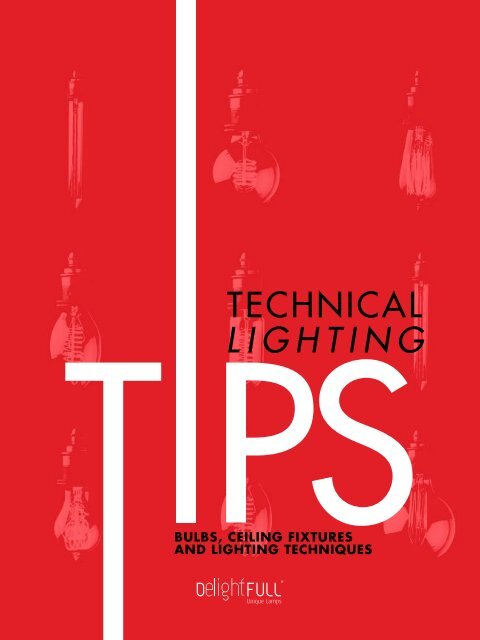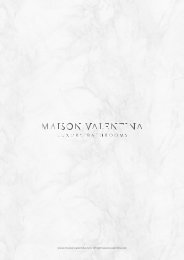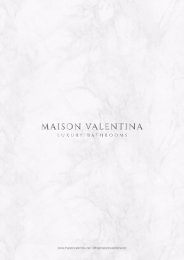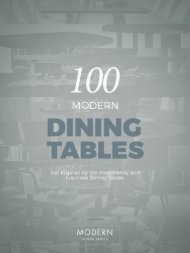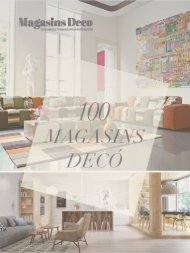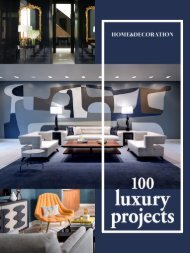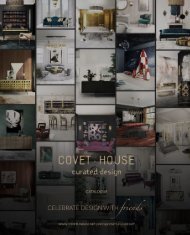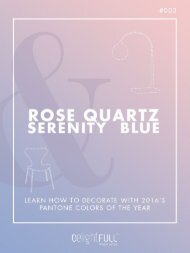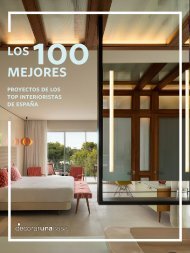Technical Lightning Tips
LED’s or Incandescent bulbs? Downlight or spotlight? Which kind of dimmer to choose? Which are the best lighting fixtures for the room you are working on? Those are some of the questions that may come up concerning lighting design. We believe that several mistakes can be avoid concerning lighting projects if you know the answers for alll this questions in advance.
LED’s or Incandescent bulbs? Downlight or spotlight? Which kind of dimmer to choose? Which are the best lighting fixtures for the room you are working on?
Those are some of the questions that may come up concerning lighting design.
We believe that several mistakes can be avoid concerning lighting projects if you know the answers for alll this questions in advance.
Create successful ePaper yourself
Turn your PDF publications into a flip-book with our unique Google optimized e-Paper software.
<strong>Technical</strong><br />
lighting<br />
bulbs, ceiling fixtures<br />
and Lighting techniques
Pag.<br />
03<br />
INTERIOR DESIGN TIPS<br />
TYPES OF BULBS<br />
AND CEILING FIXTURES<br />
highlight<br />
Pag.<br />
Pag.<br />
09<br />
FILAMENT BULBS<br />
RESISTANCE<br />
12<br />
LIGHTING TECHNIQUES<br />
DOWNLIGHT AND SPOTLIGHT.<br />
DIFFERENCES YOU MUST KNOW<br />
Pag.<br />
15<br />
TYPES OF DIMMERS<br />
CHOOSING THE CORRECT ONE
INTERIOR DESIGN TIPS<br />
TYPES OF BULBS AND CEILING FIXTURES
If you’re wondering how to choose the best lighting bulb for your<br />
interior design project, we have the answer. There are several<br />
infographics that may help you with this matter. They will show<br />
you which is the best option and they will explain you why. We<br />
really want you to be elucidated about all the bulbs you can find<br />
at the market.<br />
But there’s more about this article. We believe that several<br />
mistakes can be avoid concerning lighting projects if you know<br />
which are the best lighting fixtures for the room you are working<br />
on. Each space has special needs, and they will get their<br />
special solution… But you need to know how to do it. Unique<br />
Blog wants to help you!<br />
Bulbs<br />
Three of the most common energy-efficient lighting types include<br />
halogen incandescent bulbs, CFLs, and LEDs. Let’s see the<br />
characteristics of each one of those lighting bulbs. Even so, LED<br />
really is the the best option regarding its low energy consuption.<br />
Once again we want to recall the<br />
importance that a light bulb can<br />
have when you are developing<br />
an Interior Design project, as<br />
much as we want to help you<br />
choosing the most appropriate<br />
type of ceiling fixtures among all<br />
the options that do exist.<br />
LEDS<br />
The light emitting diode (LED) are semiconductors that convert<br />
electricity into light. LEDs are a type of solid-state lighting and<br />
are one of today’s most energy-efficient and rapidly-developing<br />
technologies. The thing is that this kind of lighting use only<br />
20%–25% of the energy and last up to 25 times longer than<br />
the traditional incandescent bulbs. More: LEDs use 25%–30%<br />
of the energy and last 8 to 25 times longer than halogen<br />
incandescents, as well. LEDs are more expensive but even so,<br />
they will make you save some money because they last a long<br />
time and have very low energy use.<br />
HALOGEN INCANDESCENT BULBS<br />
This kind of lamps have a capsule inside that holds gas<br />
around a filament to increase bulb efficiency. They are<br />
available in a wide range of shapes and colors, and they<br />
can be used with dimmers.<br />
Traditional incandescent and halogen incandescent bulbs can<br />
be mixed up. As you can read here, both incandescent and<br />
halogen bulbs are based on the concept of two parallel metal<br />
wires transmitting an electrical current to a tungsten filament<br />
that connects them, heating the filament to a point where its<br />
heat is reflected as light and they both put a glass housing<br />
around the wires and filaments to amplify the light that is<br />
produced. The major difference between an incandescent bulb<br />
and a halogen bulb is the gases that each produces within<br />
its glass bulb. The purpose of gas production is the same in<br />
that it is meant to slow evaporation of the filament and keep<br />
it from rusting. Both incandescent and halogen bulbs go dark<br />
when the filament wears out. Incandescent bulbs fill with a<br />
mixture of 93 percent argon and seven percent nitrogen, both<br />
of which are inert gases. A halogen bulb adds a halogen<br />
gas, such as iodine or bromine, creating a chemical reaction<br />
that regenerates evaporated tungsten and puts it back on the<br />
filament, helping to extend the filament’s life and therefore the<br />
life of the light bulb. However, incandescent bulbs are less<br />
efficient than halogen bulbs are, using about 90 percent of the<br />
energy that they consume to produce heat and turning less than<br />
five percent of it into light.<br />
technical lighting tips. 4
from the mind creators of<br />
introduces a<br />
unique<br />
blog<br />
a unique design vision about<br />
the design world<br />
www.delightfull.eu/blog
A halogen bulb adds a halogen<br />
gas, such as iodine or bromine,<br />
creating a chemical reaction<br />
that regenerates evaporated<br />
tungsten and puts it back on the<br />
filament, helping to extend the<br />
filament’s life and therefore the<br />
life of the light bulb.<br />
flush recessed exposed canister eyeball down spot<br />
adjustable pendant reel<br />
flush light panel suspended luminary full room<br />
luminous ceiling<br />
CFLS<br />
Compact fluorescent lamps (CFLs) are simply curly versions of<br />
the long tube fluorescent lights you may already have in your<br />
kitchen or garage. This kind of lamps uses about one-fourth less<br />
energy than traditional incandescents and lasts ten times longer<br />
than a comparable traditional incandescent bulb that puts out<br />
the same amount of light. A CFL uses about one-third the energy<br />
of a halogen incandescent. CFL bulbs are available in a range<br />
of light colors, including warm (white to yellow) tones that were<br />
not as available when first introduced. Some are encased in a<br />
cover to further diffuse the light and provide a similar shape to<br />
the bulbs you are replacing. Fluorescent bulbs contain a small<br />
amount of mercury, and they should always be recycled at the<br />
end of their lifespan.<br />
Ceiling Fixtures<br />
In what concerns lighting fixtures, there are many types you can<br />
choose, inclusively, if you need accent light. Take a look at this<br />
overview of the types of fixtures available and tips on how they<br />
can satisfy your lighting and decor needs.<br />
technical lighting tips. 6<br />
surface mounted<br />
lumininary<br />
track lighting<br />
surface mounted<br />
fixture<br />
coffered light<br />
recess<br />
suspended<br />
hanging<br />
In what concerns lighting<br />
fixtures, there are many types<br />
you can choose.
Recessed lighting sends a band<br />
of light in one direction; it can<br />
be used to provide ambient,<br />
task or accent lighting to<br />
highlight decor details.<br />
a bright idea<br />
match a lighting style with<br />
your desired buld style<br />
trims or styles<br />
bulb styles<br />
Baffles. Can minimize glare in<br />
lighting applications.<br />
The most economical choice for<br />
recessed downlighting in the<br />
open style.<br />
Standard light bulbs. Can<br />
be used in reflector and lensfitted<br />
trims for general lighting<br />
applications.<br />
PAR Bulbs<br />
technical lighting tips. 7<br />
Reflectors. Maximizes light output<br />
in residential and commertial<br />
environments.<br />
Eyeballs. Provides adjustable /<br />
directional lighting applications.<br />
Lens. Diffuse light, shield the<br />
the lamp and deal for closets,<br />
bathrooms.<br />
Parabolic Aluminized Reflector.<br />
Or PAR lamps, have built-in<br />
reflectors and are used for<br />
general lighting, “wall washing“<br />
and display lighting.<br />
Compact flourescents. Can’t<br />
be dimmed when installed in a<br />
incandescent light.<br />
Recessed lighting<br />
(the first example in the infographic you just saw) is one of the<br />
several options for ceiling fixtures. Installed above the ceiling,<br />
this type of lighting is used as focal point light. It has an opening<br />
that is in contact with the ceiling. A recessed light requires at<br />
least 6 inches of clearance above the ceiling. Recessed lighting<br />
sends a band of light in one direction; it can be used to provide<br />
ambient, task or accent lighting to highlight decor details.<br />
Do you need some guidelines for choosing and placing<br />
recessed lights? You can see many solutions on how to install<br />
recessed lighting by clicking here.<br />
Now that you know the importance a light bulb can have in any<br />
Interior Design project, and now that you know which is the most<br />
appropriate type of ceiling fixtures for your project or home,<br />
leave us some feedback. We hope this will be helpful.
vintage design blog<br />
with a breezy approach<br />
www.vintageindustrialstyle.com
FILAMENT BULBS RESISTANCE
The filament lamp is a common<br />
type of light bulb. It contains<br />
a thin coil of wire called the<br />
filament. This heats up when an<br />
electric current passes through it<br />
and produces light as a result.<br />
technical lighting tips. 10<br />
Incandescent light bulbs have filaments which are made mainly<br />
from the element tungsten, the metal element used for the<br />
filaments in incandescent light bulbs.<br />
Experiments were made with different materials to use as the<br />
filament, including natural fibres, pure metals and alloys of<br />
different metals, to find the material which had the longest life<br />
whilst glowing brightly enough to give out visible light. The metal<br />
Tungsten was found to be the best, because of its high melting<br />
point (almost 3700 K) and good resistance to electrical current.
for interior<br />
design enthusiasts<br />
and décor lovers.<br />
technical lighting tips. 11<br />
www.homedesignideas.eu
LIGHTING TECHNIQUES<br />
DOWNLIGHT AND SPOTLIGHT.<br />
DIFFERENCES YOU MUST KNOW
technical lighting tips. 13<br />
When planning a new interior<br />
design project, there are many<br />
aspects to consider. Your budget<br />
and timeframe are not the only<br />
elements in the spotlight. You<br />
really need to look very carefully<br />
at the elements that will make<br />
your project stand out.<br />
A very important part of any interior design project is ensuring<br />
that you have adequate lighting available, and that it works in<br />
a way that will enhance the environment and complement your<br />
décor. Because a bad light can transforme an expensive room<br />
into a cheap and uncomfortable place.<br />
Lighting can be quite technical but yet it is a wonderful<br />
medium to work with. It requires knowledge since you need<br />
to choose the right products to work with, and you need to<br />
choose a lighting supplier that can deliver a variety of high<br />
quality, modern lighting products for you to work with. Lighting<br />
designers can also design the perfect layout in your home,<br />
allowing you to create the ideal environment for the particular<br />
room or area in the house.<br />
Lighting Technology<br />
Lighting and equipment technology are always increasing and<br />
this means that there are literally hundreds of new products<br />
available every year. In order to use the latest design trends<br />
and learn about new products on the market, lighting designers<br />
need to constantly attend décor shows, interior design<br />
workshops, or product launches for new lighting solutions.<br />
Keeping ahead with the trends will allow you to provide<br />
the best possible service to your customers, or simply just a<br />
professional touch to your own project.
Lighting designers can also<br />
design the perfect layout in<br />
your home, allowing you to<br />
create the ideal environment<br />
for the particular room or area<br />
in the house.<br />
Lighting Techniques<br />
There are many different lighting techniques that can be used<br />
and you can manipulate light to create almost any effect you<br />
want. You can use light to place emphasis on focal points or<br />
you can use light to attract attention away from a particular<br />
point or corner in your house. You can also use different types<br />
of brightness, depending on the amount of light that you want<br />
to let into a room. Softer light provides a calmer atmosphere,<br />
where brighter lights are ideal for areas that are busy, like an<br />
entertainment area.<br />
Downlighting is a popular technique where you can add<br />
a moderate amount of light in specific areas of a room. This is<br />
ideal to use in rooms that have a lot of natural light during the<br />
day, but not so much at night. These downlights are perfect to<br />
add to a room to provide a moderate amount of light during<br />
night time.<br />
technical lighting tips. 14<br />
Task lights or Spotlights<br />
Accentuate a specific area or workplace, much like a desk.<br />
These lights should be at least 3 times brighter than the rest<br />
of the light in the room to be effective. Accent lighting adds a<br />
shimmer to make your objects like paintings and sculptures stand<br />
out. Halogen lamps (that is not the same as incandescent bulbs,<br />
as you can see here) are the best type of lighting to use for this.<br />
Just make sure that the light is at least 3 times as bright as the<br />
rest of the lights. You don’t have to be an expert in lighting for it<br />
to be effective, but sticking to basic techniques will surely help<br />
you create the perfect environment in your home. Always make<br />
sure that you buy the correct type of lighting products so that you<br />
can get that perfect effect.<br />
Main differences between downlighting and spotlight<br />
techniques: Downlight should be used for large area<br />
illumination, as it gives more even spread of light over wider<br />
area. On the other hand, spot lights should be used for<br />
highlighting specific area or display due to its narrow beam<br />
angle. Never use only spot lights in whole showroom. Spot<br />
lights should be chosen with care, as most of them cut & waste<br />
the light beam in angle adjustment.
TYPES OF DIMMERS<br />
CHOOSING THE CORRECT ONE
www.delightfull.eu<br />
technical lighting tips. 16
Dimmers can reduce the voltage<br />
supplied to the lamp, which<br />
results in a light output decrease<br />
of the light bulb. With a dimmer<br />
you may set the light levels<br />
depending on your mood. Direct<br />
advantage? You will note a<br />
reduction in consumption and<br />
that will make you save money.<br />
Another advantage is that it increases lamp life in order to<br />
replace lamps less times, so, automatically you reduce the<br />
replacement of a lamp and maintenance costs.<br />
Be carefully by choosing the correct dimmer, if you select the<br />
wrong type it may not work, could reduce lamp life or even<br />
blow the dimmer.<br />
Resistive Dimmers (Leading Edge)<br />
Compatible with resistive or inductive loads, leading edge<br />
dimmers are able to short the A/C cycle at the leading edge of<br />
the input waveform, hence the term ‘Leading Edge’.<br />
Incandescent and halogen light bulbs are the most common<br />
bulbs where leading edge dimmers are applied. Also low<br />
voltage transformers are dimmable, as well as LED drivers. These<br />
dimmers are available in 250w, 400w, 600w and 1000w<br />
modules. Note that they also have a minimum load requirement<br />
of 25w, 40w, 100w and 150w respectively.<br />
Resistive Dimmers (Trailing Edge)<br />
Trailing edge dimmers are more expensive to produce and<br />
purchase. They incorporate many features such as soft start;<br />
smooth control, silent running and multi-way dimming that<br />
promotes the life of the lamps and fittings.<br />
They are commonly used to dim laminated, wire-wound or<br />
toroidal transformers, which are certain types of low voltage<br />
transformers on the primary circuit. Trailing edge dimmers can<br />
also dim incandescent, halogen and LED lamps effectively.<br />
The price of a trailing edge dimmer is higher but it has many<br />
desirable attributes over its leading edge counterpart and in<br />
certain situations may be more appropriate.<br />
technical lighting tips. 17
Incandescent and halogen light<br />
bulbs are the most common<br />
bulbs where leading edge<br />
dimmers are applied.<br />
Inductive Dimmers<br />
Inductive dimmers aren’t used in home settings. They are located<br />
on the secondary side of a low voltage or LED lighting scheme.<br />
They are rated in VA (Volt Amps) rather than watts and have<br />
already been over rated to deal with the rush of current from the<br />
transformers, as Sye Yehya explains.<br />
Dimming Fluorescent Fittings<br />
Dimming Fluorescent Fittings are expensive to install and are<br />
mainly used for commercial applications. These can be dimmed<br />
between 3% and 100% lighting by using a suitably rated<br />
dimmer but must incorporate a separate on/off switch. Although<br />
they’re still expensive, the price will be reduced as they become<br />
more popular.<br />
Dimming LED lamps<br />
Voltage dimmable LED light bulbs can be dimmed using a<br />
normal resistive dimmer. They’ll consume very low wattages and<br />
are very energy efficient. Non-dimmable LED lamps cannot be<br />
dimmed, of course. If you fit a dimmer to non-dimmable LED’s<br />
then you’ll cause damage to the dimmer or lamps. Dimming low<br />
voltage LED lamps is also easily achieved by either dimming<br />
the driver on the primary (mains) side or on the secondary<br />
(low voltage) side. Primary side dimming is the more easiest to<br />
achieve. The LED driver would need to be of a constant current<br />
type and dimmable.<br />
technical lighting tips. 18<br />
Dimming Fluorescent Fittings<br />
are expensive to install and are<br />
mainly used for commercial<br />
applications.
www.delightfull.eu/blog | Delightfulll | delightfull.lab


